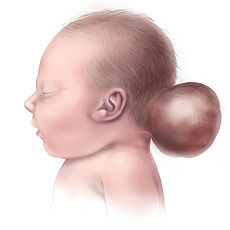Visit and Join the WeHeal Encephalocele Community.
For more information, see: CDC | Wikipedia

Encephalocele is a rare type of neural tube defect (NTD) present at birth that affects the brain. The neural tube is a narrow channel that folds and closes during the third and fouth weeks of pregnancy to form the brain and spinal cord. Encephalocele is described as a sac-like protrusion or projection of the brain and the membranes that cover it through an opening in the skull. Encephalocele happens when the neural tube does not close completely during pregnancy. The result is an opening in the midline of the upper part of the skull, the area between the forehead and nose, or the back of the skull.
Usually encephaloceles are found right after birth, but sometimes a small encephalocele in the nose and forehead region can go undetected.
What We Know About Encephalocele
How often does encephalocele occur?
CDC estimates that each year about 375 babies in the United States are born with encephalocele (1). In other words, about 1 out of every 10,000 babies born in the United States each year will have encephalocele.
What problems do children with encephalocele have?
When located in the back of the skull, encephalocele often is linked to nervous system problems. Encephalocele usually is seen with other brain and face defects.
Signs of encephalocele can include:
• Buildup of too much fluid in the brain
• Complete loss of strength in the arms and legs
• An unusually small head
• Uncoordinated movement of the voluntary muscles, such as those involved in walking and reaching
• Developmental delay
• Vision problems
• Mental and growth retardation
• Seizures
Visit and Join the WeHeal Encephalocele Community.
For more information, see: CDC | Wikipedia
WeHeal is very grateful to our valued sources of information which include Wikipedia, WebMD, ClinicalTrials.gov, Cancer.gov, Infoplease, and the US CDC (Center for Disease Control).